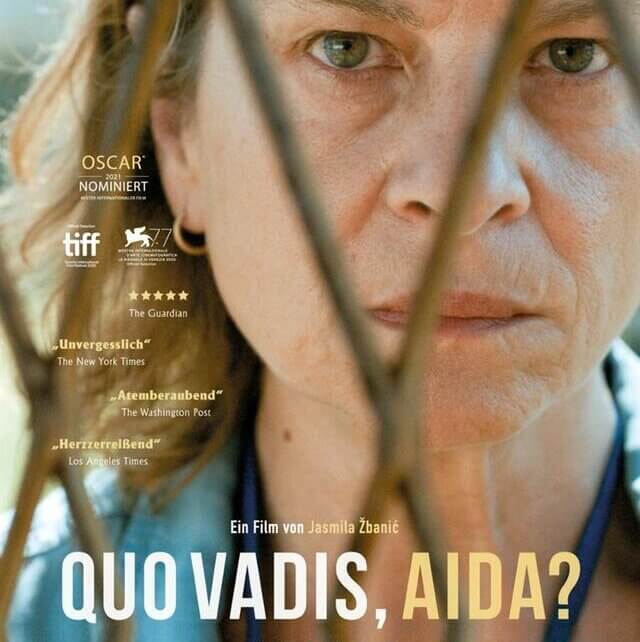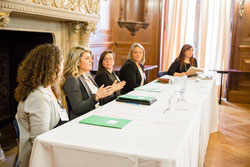The Pearson World Cinema Series hosted its showing of the 2020 Bosnian film, Quo Vadis, Aida? (Where are you going Aida?) on Feb. 1 at Pollak Auditorium. The event began with a screening of the film, followed by a discussion involving both formal commentators and audience members.
Directed and written by Jasmila Žbanić, Quo Vadis, Aida? dramatizes the events of the 1995 Serbian massacre in Srebrenica where Bosniak-Muslim men and boys were led to their death by the Serbian troops. These harsh realities are uncovered through the eyes of the film’s protagonist, Aida, a mother and a schoolteacher who works with the United Nations as a translator.
One of the night’s organizers, Christopher DeRosa, Ph.D., Associate Professor and Chair for the Department of History and Anthropology, explained the purpose behind the series and how it relates to the discussion of this particular film. “The purpose of Pearson World Cinema Series is to give the Monmouth community a chance to explore some things that the mainstream popular culture doesn’t always put right in your way,” DeRosa said.
This year series titled “Wartime Lives: Enduring and Transcending Violence and Occupation,” aims to illuminate resilience of people globally, who find themselves caught in the wirlwind of war.
“In the case of Quo Vadis, Aida?, we wanted to consider the absolute dread of what happens when the security we take for granted suddenly disintegrates. This year’s series has shown time and again that civil society is fragile, and life during wartime exposes us to murderous bullies who have no regard for it,” continued DeRosa.
Thomas Pearson, Ph.D., Professor Emeritus of History, former Provost, and the founder of the series, was in attendance and he provided greater context about the film’s protagonist and her connection to the massacre.
He said, “The film’s focus on Aida Selmanagic, an English teacher at the center of the crisis as a translator for the United Nations’ peacekeeping forces trying futilely to protect Bosnian Muslim men — including her husband and two sons — from slaughter by Serbian troops, provides a harrowing look at the personal and professional choices and conflicts faced by courageous, patriotic women at a moment of truth.”
Marina Vujnovic, Ph.D., APR, Professor for the Department of Communication, elaborated on how the narrative employed by Žbanić reveals the tragedy of the event.
“This movie has a powerful and poetic narrative. On the micro level, it’s a story of a mother’s desperate attempt to save her family in the face of impending atrocities; on the macro level, it is a story of the international community’s moral failure to protect the people who they were supposed to protect,” began Vujnovic.
Vujnovic has personal experience with the Serbian massacre as she was 20 years old living in Croatia (which neighbors Bosnia and Herzegovina) in 1995 when the events described in the movie took place.
“At the time I was a student of journalism and covered the war for a local newspaper Otok Ivanic.
Although I didn’t cover from Bosnia but only locally in Croatia, I was still not aware of the large-scale atrocities committed by the Bosnian-Serb army against the Muslim population,” she expanded.
“Years later, in 2009, I wrote a research article, ‘The Blame Game: News Framing of the Srebrenica Massacre, 1993-1995,’ published in the Journal of International Communication. The article examines how news media used official sources that ended up masking the actual events in news reporting, leaving both the local and global public unaware of what exactly took place in Srebrenica. Only years later did we fully undersand that we were witnessing the largest genocide against civilian population committed in Europe since the Second World War. To this day only 7,000 out of 8,372 victims have been identified. It took more than 10 years for the international community to officially name the Srebrenica massacre a genocide, and it took International Criminal Tribunal for the Former Yugoslavia (ICTY) another ten years to find Ratko Mladic, Serbian general portrayed in the movie, guilty for the atrocities committed and sentence him to life in prison,” said Vujnovic.
Both DeRosa and Vujnovic added context for the audience members. DeRosa, a historian, added historical depth, and Vujnovic added journalism and media perspectives, as well as reflections from her past.
DeRosa reflected, “We see in this film the pathetic failure of international protection for Bosnian Muslim people in the 1990s. We’ve had other films and events at Monmouth over the years that have dramatized the perils of military intervention — that too is to be regarded with respectful caution, and in some cases, shame. But as we see in the Russo-Ukrainian war now, the absence of western intervention is by no means a default state of peace and freedom.”
John P. Hanly, Ph.D., Associate Professor and Chair for the Department of English, was also present during the film’s showing.
“Bosnian director Jasmila Žbanić’s perceptive and moving dramatization of the 1995 Srebenica massacre was an outstanding and timely choice for inclusion in this year’s Pearson World Cinema Series,” explained Hanly. “Watching the film, I not only felt sympathy for the Bosnian victims and anger at the Serbian perpetrators, but I also felt frustration with our liberal institutions’ inability to stop the genocide and guilt about my prior lack of awareness and my attendant complicity.”
“I especially appreciated how the discussion after the film, led by Professor Vujnovic, who is from former Yugoslavia and was working as a war journalist in what is now Croatia at the time of the massacre, illuminated the film’s cultural context and helped me more fully understand the deeper thematic significance of various key details I had overlooked,” emphasized Hanly.




